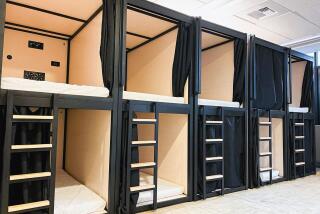Exploring the Advantages of Togetherness : Cohousing: A Contemporary Approach to Housing Ourselves by Kathryn Camant and Charles Durrett (Habitat Press/Ten Speed Press: $19.95).
- Share via
“Cohousing” is a term that the husband-and-wife authors, who also are the owners of a design and consulting firm, have trademarked in the hopes of promoting and selling their planned-community models in the United States. The book derives from their visits to Denmark in the ‘80s. As in this country, housing in Denmark has become expensive and urban life has turned a bit sour.
Aesthetically pleasing and environmentally sound attached houses are owned by individuals, with common rooms for food preparation, dining, laundry facilities, recreation (several communities sported “pillow rooms” for pillow fights) and even lodging guests.
There are obvious advantages to living in a community such as Trudeslund, Denmark. Tired and hungry after a long commute, you can dine in the common room and can reciprocate--once a month--by preparing dinner, helped by others and your children. Built-in baby-sitting, playmates for children, and an on-site “store” for necessities are other advantages.
Perhaps, more important than shared resources is the sense of improved family life, which “opens toward the community, but still has family as a base.”
For many Americans, communality conflicts with a sense of strict privacy and the “right” to own a single-family dwelling. Yet, so enthusiastic is this book, so filled with lovely photographs, architectural renderings and detailed advice about how to bring together like-minded cooperative people, that many readers will want to explore it for alternative choices.
More to Read
Sign up for our Book Club newsletter
Get the latest news, events and more from the Los Angeles Times Book Club, and help us get L.A. reading and talking.
You may occasionally receive promotional content from the Los Angeles Times.







